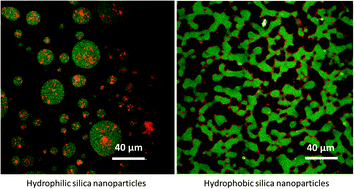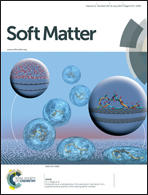Dynamics and rheology of nonpolar bijels†
Abstract
Bicontinuous, interfacially jammed, emulsion gels (bijels) are a novel class of materials composed of two immiscible phases with interpenetrating domains that are stabilized by a monolayer of colloidal particles at the interface. However, existing bijel systems so far all consist of at least one polar fluid, which is believed to be essential to induce electrostatic repulsion for stabilizing interfacial particles. It is not known whether two nonpolar fluids can form a bijel. Here, we experimentally achieve a bijel using styrene trimer and low molecular weight polybutene—two nonpolar fluids that are similar to polymer blends, which are important in technical applications. By combining laser scanning confocal microscopy, cryo-SEM and rheology measurement, we systematically investigate the dynamics and rheology of this nonpolar bijel. In contrast to previous studies on polar bijels, we observe the formation of localized regions of high particle concentration or “particle patches” on the interface which assemble during coarsening. We also provide the first quantitative relation between the morphology of a bijel, the interfacial particle coverage and the shear modulus during bijel coarsening. Moreover, we reveal a previously unnoticed increase in the elastic modulus of bijels that can be attributed to the rearrangement of interfacial particles at long time scales. In addition, we also found a hydrophobic particle framework that survives after the direct remixing of the nonpolar bijel. Our study provides important insights into the formation of bijels and is the first step to explore the missing link between polar bijels and particle-stabilized bicontinuous polymer blends.


 Please wait while we load your content...
Please wait while we load your content...